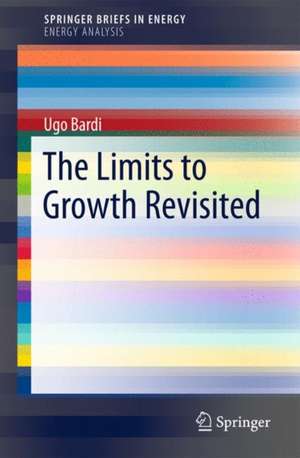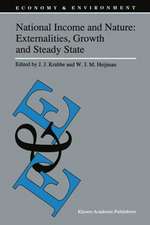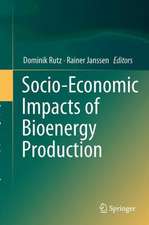The Limits to Growth Revisited: SpringerBriefs in Energy
Autor Ugo Bardien Limba Engleză Paperback – iun 2011
Din seria SpringerBriefs in Energy
-
 Preț: 345.89 lei
Preț: 345.89 lei -
 Preț: 345.89 lei
Preț: 345.89 lei -
 Preț: 376.04 lei
Preț: 376.04 lei -
 Preț: 377.35 lei
Preț: 377.35 lei -
 Preț: 476.42 lei
Preț: 476.42 lei -
 Preț: 343.36 lei
Preț: 343.36 lei -
 Preț: 374.85 lei
Preț: 374.85 lei -
 Preț: 376.59 lei
Preț: 376.59 lei -
 Preț: 477.72 lei
Preț: 477.72 lei -
 Preț: 176.35 lei
Preț: 176.35 lei -
 Preț: 380.07 lei
Preț: 380.07 lei -
 Preț: 376.22 lei
Preț: 376.22 lei -
 Preț: 377.95 lei
Preț: 377.95 lei -
 Preț: 376.43 lei
Preț: 376.43 lei -
 Preț: 377.73 lei
Preț: 377.73 lei -
 Preț: 343.00 lei
Preț: 343.00 lei -
 Preț: 377.35 lei
Preț: 377.35 lei -
 Preț: 377.95 lei
Preț: 377.95 lei -
 Preț: 444.35 lei
Preț: 444.35 lei -
 Preț: 348.84 lei
Preț: 348.84 lei -
 Preț: 412.30 lei
Preț: 412.30 lei -
 Preț: 377.73 lei
Preț: 377.73 lei -
 Preț: 375.62 lei
Preț: 375.62 lei -
 Preț: 380.07 lei
Preț: 380.07 lei -
 Preț: 376.80 lei
Preț: 376.80 lei -
 Preț: 376.22 lei
Preț: 376.22 lei -
 Preț: 479.67 lei
Preț: 479.67 lei - 15%
 Preț: 463.85 lei
Preț: 463.85 lei -
 Preț: 476.79 lei
Preț: 476.79 lei -
 Preț: 375.23 lei
Preț: 375.23 lei -
 Preț: 379.09 lei
Preț: 379.09 lei -
 Preț: 376.22 lei
Preț: 376.22 lei -
 Preț: 409.43 lei
Preț: 409.43 lei - 15%
 Preț: 462.38 lei
Preț: 462.38 lei -
 Preț: 414.21 lei
Preț: 414.21 lei -
 Preț: 375.62 lei
Preț: 375.62 lei -
 Preț: 374.30 lei
Preț: 374.30 lei -
 Preț: 376.22 lei
Preț: 376.22 lei - 15%
 Preț: 463.35 lei
Preț: 463.35 lei -
 Preț: 381.72 lei
Preț: 381.72 lei -
 Preț: 379.09 lei
Preț: 379.09 lei -
 Preț: 375.62 lei
Preț: 375.62 lei -
 Preț: 376.80 lei
Preț: 376.80 lei -
 Preț: 374.46 lei
Preț: 374.46 lei -
 Preț: 477.56 lei
Preț: 477.56 lei -
 Preț: 379.48 lei
Preț: 379.48 lei -
 Preț: 374.30 lei
Preț: 374.30 lei -
 Preț: 479.47 lei
Preț: 479.47 lei -
 Preț: 378.12 lei
Preț: 378.12 lei
Preț: 463.35 lei
Preț vechi: 545.12 lei
-15% Nou
Puncte Express: 695
Preț estimativ în valută:
88.69€ • 96.37$ • 74.55£
88.69€ • 96.37$ • 74.55£
Carte tipărită la comandă
Livrare economică 21 aprilie-05 mai
Preluare comenzi: 021 569.72.76
Specificații
ISBN-13: 9781441994158
ISBN-10: 1441994157
Pagini: 136
Ilustrații: XIII, 119 p. 22 illus., 6 illus. in color.
Dimensiuni: 155 x 235 x 13 mm
Greutate: 0.2 kg
Ediția:2011
Editura: Springer
Colecția Springer
Seriile SpringerBriefs in Energy, Energy Analysis
Locul publicării:New York, NY, United States
ISBN-10: 1441994157
Pagini: 136
Ilustrații: XIII, 119 p. 22 illus., 6 illus. in color.
Dimensiuni: 155 x 235 x 13 mm
Greutate: 0.2 kg
Ediția:2011
Editura: Springer
Colecția Springer
Seriile SpringerBriefs in Energy, Energy Analysis
Locul publicării:New York, NY, United States
Public țintă
ResearchCuprins
Foreword.- 1. Introduction.- 2. The story of “The Limits to Growth”.- 3. Of models and simulations.- 4. System dynamics modeling.- 5. Modeling the real world: whaling in 19th century.- 6. World modeling by system dynamics.- 7. Criticism to “The Limits to Growth”.- 8. Mineral Resources as Limits to Growth.- 9. Technological Progress and Limits to Growth.- 10. The Political Debate.- 11. The Return of World Modeling.- 12. Conclusion: the challenges ahead.- 13. About the author.- 14. Acknowledgements.
Textul de pe ultima copertă
“The Limits to Growth” (Meadows, 1972) generated unprecedented controversy with its predictions of the eventual collapse of the world's economies. First hailed as a great advance in science, “The Limits to Growth” was subsequently rejected and demonized. However, with many national economies now at risk and global peak oil apparently a reality, the methods, scenarios, and predictions of “The Limits to Growth” are in great need of reappraisal. In The Limits to Growth Revisited, Ugo Bardi examines both the science and the polemics surrounding this work, and in particular the reactions of economists that marginalized its methods and conclusions for more than 30 years. “The Limits to Growth” was a milestone in attempts to model the future of our society, and it is vital today for both scientists and policy makers to understand its scientific basis, current relevance, and the social and political mechanisms that led to its rejection. Bardi also addresses the all-important question of whether the methods and approaches of “The Limits to Growth” can contribute to an understanding of what happened to the global economy in the Great Recession and where we are headed from there.
- Shows how “The Limits to Growth” is a subject more relevant today than when the book was first published
- Demonstrates how scenario-building using system dynamics models or other methods is an essential tool in understanding possible futures
- Examines the factors that may lead to the rejection of good science when the conclusions are unpleasant
- Separates the reality that the future can never be predicted with certainty from the need to prepare for it
Caracteristici
Shows how "The Limits to Growth" is a subject more relevant today than when the book was first published Demonstrates how scenario-building using system dynamics models or other methods is an essential tool in understanding possible futures Examines the factors that may lead to the rejection of good science when the conclusions are unpleasant Separates the reality that the future can never be predicted with certainty from the need to prepare for it Includes supplementary material: sn.pub/extras

















